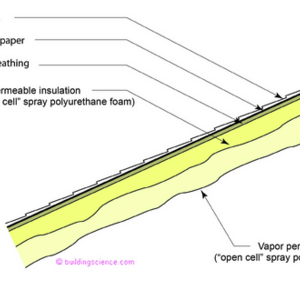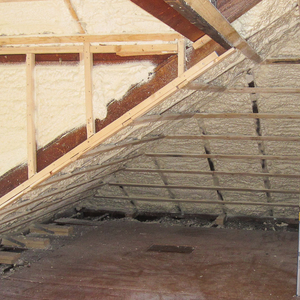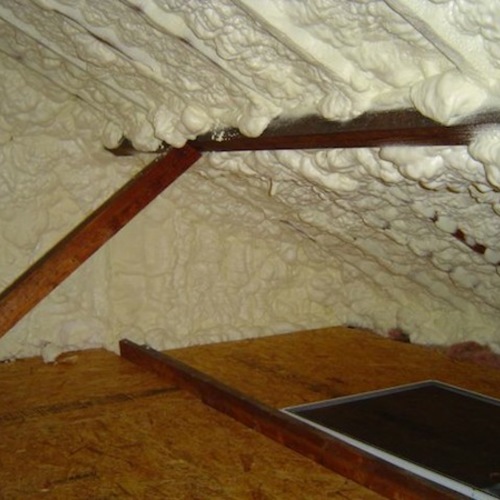
Aun Safe settled on spray polyurethane foam as the best way to turn his attic into a conditioned space. Although the open-cell foam between the 2×8 rafters would not be enough to get the attic to R-38, it was the best Aun Safe could do at the time.
“My question is whether I got what I paid for,” Safe writes in a Q&A post. The house is in the Southeast, between Climate Zones 3 and 4, where code requires attic insulation of R-38 and R-49 respectively.
The foam installer said there would be an average of 6 inches or 7 inches of foam in each rafter bay. But as Aun Safe explains, and photos of the job show, at least 30% of them are under-filled by 3 inches or more, meaning there is less than 4 inches of installed foam in those bays.
“I reiterate that this is not some small number of rafter bays,” he writes, “in which case I would just ignore it. It’s close to half of the rafter bays that have noticeable areas of significantly less than 6-inch foam depth.”
He guesses that the installers were just trying to save themselves the trouble of trimming back excess foam.
“Should I care?” he asks. “Is this reasonable? I simply don’t know what typical industry expectations should be for this sort of work, and I don’t want to complain unless a complaint is warranted (I am otherwise happy with the work that they did.)”
Does this fall within normal limits, or is it a problem that Aun Safe will have to pursue with the installer? That’s where we start this Q&A Spotlight.
Is it open- or closed-cell foam?
There are two main types of polyurethane spray foam: open- and closed-cell. They are of different densities, have different insulating…
Weekly Newsletter
Get building science and energy efficiency advice, plus special offers, in your inbox.

This article is only available to GBA Prime Members
Sign up for a free trial and get instant access to this article as well as GBA’s complete library of premium articles and construction details.
Start Free TrialAlready a member? Log in















One Comment
I would recommend that you do not pay the insulation contractor until the rafters are fully sprayed and shaved flush. There will be some small indentions in the foam but it should not be a problem. I would press on all of the foam and make sure the cavity it completely free from voids. Usually when you see foam installed unprofessionally, it has large voids from improper mixing, heating, and installation. One easy way to see if voids are present is to stick your hand through the foam until you make contact with the roof decking. You can have the foam contractor fill these holes when he comes back to complete the job. Take a piece of straight wire, measure it to the desired thickness and mark it with tape, insert it into the foam and anything not to that depth needs to be resprayed.
If you are in Zone 3/Zone 4 you do not need closed cell foam. Open cell foam is ideal. I completely disagree with the comment that you should install closed cell first. In zone 3 , closed cell will more often trap moisture above it and this will lead to rotting out your roof decking. If the open cell is installed correctly without voids between it and the sheathing, there is no way moisture can accumulate at the sheathing.
I completely disagree with installing any kind of Intello Plus or Membrain. It is not necessary in Zone 3. Moisture should be allowed to move freely in both directions. I can almost guarantee that in Zone 3 that a 2 x 6 rafter filled with open cell foam will out-perform or at least perform as well as R38 batts or Rockwool batts installed in a 2 x 12. Installing radiant barrier over batts, is totally unnecessary. Installing 2 x 4 's perpendicular is a complete waste of money.
In Zone 3, it is more important to get the cavity air tight and insulated moderately with spray foam and to have the HVAC equipment properly sized and installed inside of the conditioned space.
I have been in the insulation business for almost 40 years. I worked in cellulose manufacturing and installation for the first 30 before I opened a "spray foam only business" 10 years ago, I have insulated attics and slanted ceilings with almost every R-value possible with almost every product available. I have tested almost every scenario possible with a blower door and an infrared camera. I know the comfort, utility bills, are durability achieved. Short and simple......in the south in Zone 3, R-value after 6" of open cell foam is almost always overkill and I can show anyone, anytime, how to do it.
Todd Witt
Synergy Home Performance
Log in or become a member to post a comment.
Sign up Log in